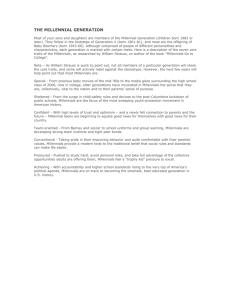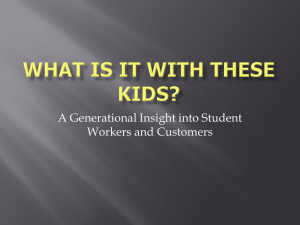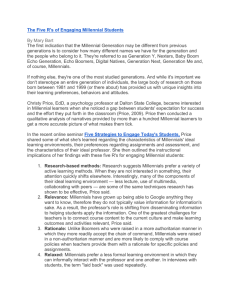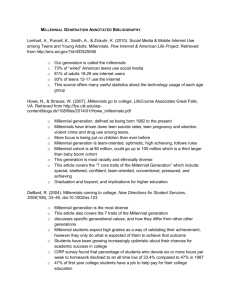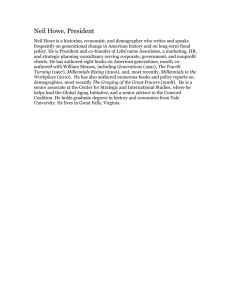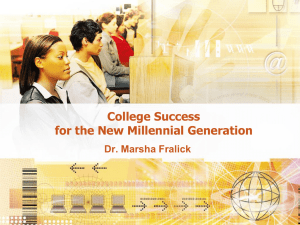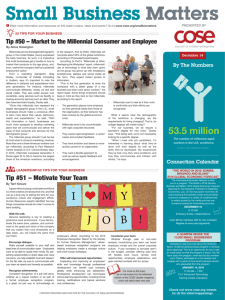Maturing with the millennials Are organisations prepared for the
advertisement
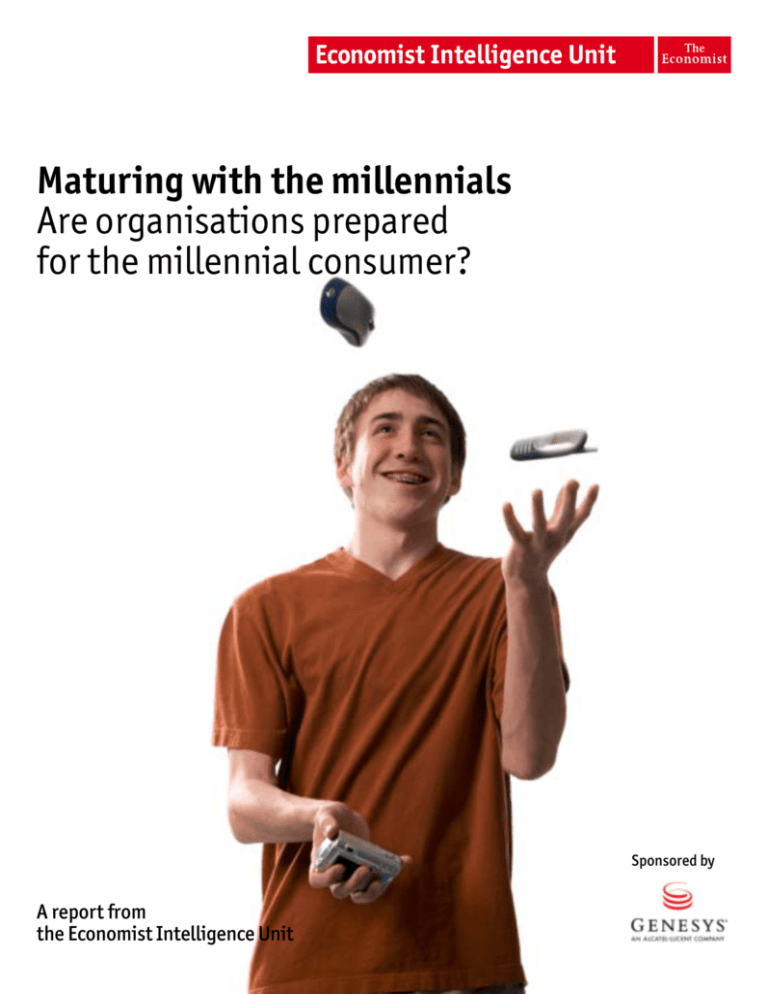
Maturing with the millennials Are organisations prepared for the millennial consumer? Sponsored by A report from the Economist Intelligence Unit Maturing with the millennials Are organisations prepared for the millennial consumer? Economist Intelligence Unit 2008 Preface Maturing with the millennials: Are organisations prepared for the millennial consumer? is an Economist Intelligence Unit executive summary, sponsored by Genesys. In May and June 2008, the Economist Intelligence Unit carried out a survey of senior executives around the world on the steps they are taking to attract and retain millennial consumers. The Economist Intelligence Unit executed the survey, conducted the analysis and wrote the report. The findings and views expressed in the report do not necessarily reflect the views of the sponsor. Shaun Young was the editor and project manager. Marie Glenn was the author of the report. Danielle Noble was responsible for layout and design. September 2008 1 Maturing with the millennials Are organisations prepared for the millennial consumer? Economist Intelligence Unit 2008 Who took the survey? Of the 164 executives who took part in the survey, 29% came from North America, 31% from Europe, 30% from AsiaPacific and 10% from the rest of the world. Participants represented 19 different industries. One-third of respondents’ organisations had annual revenue greater than US$1bn and just over one-half (51%) had less than US$500m in revenue. Board members and CEOs comprised 30% of respondents. CFOs, CTOs and other C-level executives made up an additional 19%. The remainder was split among other senior and middle management functions. Introduction T he baby-boomer generation is a demographic group that has been studied closely for decades. Its influence on everything from consumer spending to public finance has captured headlines and shaped corporate attitudes. Yet, as baby-boomers move towards retirement, an even larger generation with potentially greater influence is emerging. These are the millennials or generation Y, approximately 80m individuals born between 1982 and 2001 in the US alone. This generation outnumbers baby-boomers today, and its ranks will continue to grow in influence as the majority of millennials reach adulthood in the next decade. That the millennials will affect business and the marketplace is already assured. Social networking sites and Web 2.0 tools all bear their stamp. Millennials have grown up in the digital era and live in a mediasaturated environment. Moreover, they have billions of dollars in collective purchasing power. In an era of text messaging and online interaction, what are companies doing to tailor the customer experience for the millennial generation? To address this question, the Economist Intelligence Unit, on behalf of Genesys, surveyed 164 C-level and other senior executives from around the world to understand how they are attracting and retaining millennial consumers. The main findings of the survey are outlined below. z Respondents overwhelmingly agree that the millennials have specific marketplace needs, but few organisations have formally prepared for the millennial customer in their strategic or marketing plans. z When it comes to purchasing products and services, corporate reputation and brand are less important with the millennials than peer recommendation and viral marketing (that is, online promotional communications passed from one customer to another). Moreover, respondents say it is convenience, more than price, that drives millennial purchasing decisions. 2 Maturing with the millennials Are organisations prepared for the millennial consumer? Economist Intelligence Unit 2008 z Companies have not kept pace with the millennials’ preference for interacting through newer, community-based technologies, as most firms continue to rely on telephone, e-mail and store/office-front points of contact. z To attract and retain millennials as customers, organisations will need to adapt business processes to enrich the customer experience and allow greater choice in customising products and services. An emerging market with high expectations Executives overwhelmingly agree (81%) that each generation has specific work and marketplace needs, but are split on which demographic group should receive the greater share of market investment. Forty-two percent of respondents believe that a bigger share of investment should go towards younger millennial customers, and 39% say that it should be allocated to established demographic groups such as generation X and baby-boomers. Although 60% of respondents report that millennials comprise less than one-quarter of their total customer base, three-quarters believe that this young and growing generation will have a modest to major impact on their business and lead to organisational change. Younger respondents, those under 44 years of age, tend to believe that millennials will have a greater impact on the organisation than their older counterparts. Still, any investment in serving millennials is likely to have a coat-tail effect as the technologies, customs and social norms favoured by millennials gain increasing public acceptance. 3 Maturing with the millennials Are organisations prepared for the millennial consumer? Economist Intelligence Unit 2008 Convenience, customisation, community and “cool” S urvey respondents illustrated a sophisticated understanding of the consumer profile of the millennial. A sampling of comments point to convenience, customisation, community and “cool” as motivating factors for millennials. Others include “fast, reliable service”, “frictionless interaction”, a “tailored approach”, “honesty and trust” and a “personal touch”. Customisation, or customer co-creation, is especially important to millennials, according to executives. Nearly 40% of those surveyed believe that companies should allow customers greater choice in designing or tailoring their products, with 32% noting that companies should solicit direct input from millennials in the product creation process. This idea of individually crafting the service or product received seems tied to this young generation’s interest in forming fluid, dynamic relationships with companies, which some survey respondents say help millennials “feel special”. Seventy-one percent of the respondents say that when it comes to purchasing decisions, millennials care most about convenience, followed by overall style and taste (69%), peer recommendation (67%) and accessibility (65%). Even more striking, executives believe that price—a traditional influence on a purchasing decision—is one of the least important buying factors for millennials. “Top customer service is a priority,” says one survey respondent. “Price is not.” Executives point to enriched content, enhanced online experiences and peer validation as among the most effective communication channels in serving millennials. Throughout the survey, executives downplay the importance of traditional corporate assets, such as reputation and brand, as key influencing factors for millennials. They recognise that many in this generation find direct one-on-one business-to-consumer (B2C) marketing to be less persuasive in shaping opinion than social consumer-to-consumer recommendations. Convenience over cost Percentage of executives that believe the following factors are more important in driving purchasing and service decisions among millennials than other demographic groups Convenience 71 Style and taste 69 Peer recommendation 67 Accessibility or portability 65 Brand 62 Customer experience interacting with the company 41 Company reputation 33 Familiarity with the product or service 32 Price 29 Warranty and guarantee coverage 14 4 Maturing with the millennials Are organisations prepared for the millennial consumer? “Customer service is essential. Millennials want to feel special.” Respondent commentary Economist Intelligence Unit 2008 This shift has implications for customer service since peer recommendations are typically borne out of direct consumer experience. To the extent that interaction is positive or poor, millennials can (and often do) use their expertise with portable, real-time technologies to provide immediate feedback. The viral nature of these responses can have a swift and powerful impact on a business. Mismatch between market awareness and business readiness Executives surveyed attribute these leading characteristics to millennnials: ease with technology, willingness to challenge convention and developing fresh, innovative ideas. Nonetheless, more than one-half of respondents say that their organisation does not have a strategy in place for targeting, servicing or retaining millennials as customers. In what may be a reflection of the high proportion of young people in their overall populations, the Middle East and Africa was the only region to deviate from this pattern: 60% of respondents in that region indicate that they have a specialised strategy for approaching millennial consumers. There appears to be little sense of urgency in addressing the gap between market awareness and business readiness. Most respondents seem comfortable with their present competitive standing: more than three-quarters believe that they fare as well or better than their peers in serving the needs of millennials. This stance presents both risks and opportunities, however. On the one hand, it presents an opportunity for companies seeking to assert themselves in targeting this young and influential market. On the other hand, companies will face increased pressure to reach millennials through their favourite channels, such as social networking, or risk losing competitive ground. Attracting and retaining millennials as customers The proliferation of blogs, podcasts, videos, chatrooms, social networking sites and other online interactive communication has changed the corporate-customer relationship. In the past, customers tended to go directly to the company to enquire about a product, make a purchase or raise a complaint; today they increasingly go online. On the web, they learn, shop and share their experiences, both positive and negative, with sometimes startling consequences. Many companies took note of the widely publicised example of the frustrated AOL customer who, upset at how difficult it was to cancel a subscription, recorded every step of the negative customer service experience online. The story went viral from there, eventually making its way onto MSNBC and The Wall Street Journal. For many companies, these customer experiences serve as cautionary tales. No generation is more active online than millennials. In a pre-Facebook world, companies could largely control the message; today, that is no longer the case. Far from serving as a back-office function, customer service will increasingly act as the public face of the organisation. While survey respondents appear to acknowledge the need for new tactics to target the millennial customer, their responses indicate a gap in readiness. The majority of executives point to “edgier” marketing techniques, such as viral marketing, peer-to-peer recommendations and targeted sponsorship of programmes with high millennial concentrations as the most popular forms of customer contact for millennials. Yet, at the same time, respondents acknowledge that such marketing tactics 5 Maturing with the millennials Are organisations prepared for the millennial consumer? Economist Intelligence Unit 2008 Methods to reach millennials Percentage of executives that believe the following techniques are most effective in targeting millennials Participation in viral marketing and peer-to-peer recommendation sites 41 Sponsorship or ads in areas of interest to millennials (eg, extreme sports, social networking sites) 36 Delivery of a great product at a great price 35 A focus on millennials' key influencers (eg, parents, peers) 30 Contribution to social causes that millennials support 28 Contribution to corporate or issue blogs 21 Messages to millennials through wireless text messaging 21 Contests, promotions, and retail tie-ins 19 Online games for company website 12 require both cultural and technological changes and are not the technologies that their organisations predominantly use for attracting and retaining millennials today. Around the globe, telephone, e-mail and physical store or office fronts remain the primary points of contact for organisations, although regional differences exist. Asian respondents rely most heavily on physical locations (45%), while North American respondents say that the telephone is their principal channel (50%). West and east Europeans leverage e-mail technologies more than other regions (52% and 56%, respectively), while the Middle East and Africa are split evenly between telephone, e-mail and storefront (7% each). Across all regions, few respondents appear to have embraced new technologies such as webinars, online customer service and blogs as a means of providing consumer information and access. These instantly accessible, online tools are not used even though 44% of respondents indicate that communicating the right messages in the right medium and at the right time ranks as their biggest challenge. Customer contact implications More than one-third of all executives cite the goal of offering superior customer service and value as their main customer priority over the next three years. Moreover, nearly two-thirds of respondents agree that customer service is a competitive advantage and critical to growing and retaining their customer base. Companies such as Dell Computer, Comcast and Southwest Airlines increasingly monitor social networking traffic. Recognising that customer loyalty ties directly to customer experience, these organisations see their customer contact departments as the profit centres of the future—and not the cost centres of the past. This is especially true when it comes to courting millennial customers. Some millennials have been pleasantly surprised to find that a customer service grievance aired on Twitter (a micro-blogging, social networking service) can generate an almost immediate corporate response. But these companies are still largely the exception. Survey results show that most organisations around the world recognise that more needs to be done to prepare customer service professionals to 6 Maturing with the millennials Are organisations prepared for the millennial consumer? Economist Intelligence Unit 2008 Support millennials electronically in the future Net percentage (percentage of “less important” subtracted from “more important” responses) from surveyed executives showing their group opinion on the importance of the following customer service preferences for millennials compared to other generations, over the next three years Online support 78 Email support 67 Support using corporate blogs 37 Support with wireless text messaging 36 Support with new clinics, seminars or tutorials on specific subjects 22 In-office/in-home support 2 In-store support 0 Telephone support -5 respond to the new technological and communications environment. This requires both resources and training to use customer contact communications to gain a competitive advantage. Technologies and customer feedback mechanisms must evolve to rebalance the customer contact portfolio. In the future, telephone and in-store contact will occupy a smaller share of contact offerings, say executives, to be replaced with increasing use of online support, e-mail, blog and wireless text messaging support. In Europe, 84% of respondents indicate that online support will be the customer service channel of choice for millennials. The Middle East and Africa underscore this finding, citing e-mail (90%) and online support (80%) as the most popular support tools over the next three years. Wireless text messages appeal to many across the regions, while blogs rank low on the priority list everywhere except North America and the Middle East and Africa. Regional differences aside, the survey data clearly point to the widening global preference of online technologies as the primary means of future customer connection. Customer contact can offer a great opportunity for a company to distinguish itself in the digital environment. Forty-one percent of survey respondents recognise that online communities in which customers can post comments are the most effective way to serve millennial customers. While some organisations have been quick to adapt, using social networking sites and other new media to answer questions, exchange information and increase response times, many others find themselves tied to more traditional forms of communication. Yet, senior executives currently cite e-mail, telephone and online customer support as the channels of customer support on which millennials rely. In the light of this gap between market awareness and business readiness, customer service will increasingly become a key strategic consideration and priority for C-level executives over the next five years. 7 Maturing with the millennials Are organisations prepared for the millennial consumer? Economist Intelligence Unit 2008 Conclusion M illennial influence has yet to reach its peak, but its force is already being felt. The young demographic group continues to grow in buying power and as a percentage of the overall population. No generation in history has been so prepared at so young an age to use technology as an agent for change. Millennials’ ease and access to on-the-go, anytime computing has, in a few short years, spawned new channels of communication, collaboration and commerce. These channels increasingly shape the millennial buying experience. With superior customer service identified as a strategic cornerstone for most global organisations, executives will need to adapt business processes and exploit technology to enrich and personalise the customer experience. Indeed, failing to consider the customer contact preferences of millennials would be WOMBAT (a waste of money, brains and time), as millennials would note in text messages. 8 Appendix Survey results Maturing with the millennials Are organisations prepared for the millennial consumer? Economist Intelligence Unit 2008 Appendix: Survey results What are your organisation’s top customer priorities over the next three years? Select up to three (%) Creating superior customer service and value 37 Entering new markets internationally 35 Increasing the value of the brand 34 Attracting new customers regardless of customer demographic 30 Increasing sales into existing customer base 24 Retaining existing customers regardless of customer demographic 20 Driving innovation through R&D 20 Improving speed to market 18 Increasing market share domestically 16 Lowering production costs 15 Attracting and retaining new, younger customers (eg, millennials) 13 Attracting and retaining new, older customers (eg, Generation X and Baby Boomers) 12 Other, please specify 1 Don’t know/Not applicable 2 Does your organisation have a strategy for targeting, attracting or retaining millennials as customers? Over the next three years, what impact do you expect the millennial generation to have on your organisation as customers? (%) (%) No 54 A major impact–will lead to significant change across the organisation Yes 30 32 A modest impact–will lead to moderate or isolated areas of change 45 Little or no impact–will have no noticeable affect 21 Don’t know/Not applicable 4 9 Don’t know/Not applicable 14 Appendix Survey results Maturing with the millennials Are organisations prepared for the millennial consumer? Economist Intelligence Unit 2008 How strongly do you agree with the following statements? Please rate each option. “When determining where to make business investments over the next three years, management should recognise that... (% respondents) Strongly agree Agree Neutral Disagree Strongly disagree Don't know/Not applicable ...each generation has specific work and marketplace needs that must be addressed.” 26 55 13 41 1 ...no distinction between generations is necessary as all share the same core desires for work/life balance, and high quality goods, etc.” 3 17 15 46 18 1 ...younger customers (millennials) should receive greater investment since they are the market/workforce of the future.” 8 34 43 12 2 1 ...established demographics (gen X and baby boomer) represent today’s market/workforce and should receive greater investment.” 7 32 38 20 2 1 Which of the following are the biggest challenges for your organisation in addressing the needs of the millennial customer? Select all that apply (%) Communicating the right messages in the right medium at the right time 44 Understanding how to attract and retain this segment 43 Leveraging the technologies used by millennials (eg, text messaging and blogs) 40 Obtaining accurate insights on trends and consumer behavior 38 Getting new products/services to market faster 32 Customising products/services for this segment 27 Tailoring customer service to this segment 24 Minimising churn and attrition 24 Updating existing products/services more frequently 23 Managing the costs of marketing and recruiting to this segment 20 Other, please specify 1 Don’t know/Not applicable 10 10 Appendix Survey results Maturing with the millennials Are organisations prepared for the millennial consumer? Economist Intelligence Unit 2008 In your opinion, what do you consider to be the most distinctive characteristics of millennials? Select up to three Compared to your competitors, how well do you think your organisation has responded to serving the needs of millennial consumers? (%) (%) Much better Ease with technology 74 Willingness to challenge convention and standard business practices 4 Better 20 38 About the same Innovation and fresh ideas 53 32 Worse Interest in building relationships, teams and networks 8 30 Much worse Represents a large and growing market 3 28 Don’t know/Not applicable Comfort communicating feedback 12 20 Commitment to social causes 18 High levels of disposable income 16 Reliable work ethic 3 Other, please specify 2 Don’t know/Not applicable 3 Compared to other generations, how important are the following factors in driving purchasing and service decisions among millennials? Please rate each option (% respondents) More important Neutral Less important Don't know/Not applicable Price 29 43 23 5 Convenience 71 22 4 3 Brand 62 26 8 4 Familiarity with the product or service 32 41 22 5 Accessibility or portability 65 25 6 4 Company reputation 33 37 24 5 21 6 5 20 6 5 17 4 Peer recommendation 67 Style and taste 69 Customer experience interacting with the company 41 38 Warranty and guarantee coverage 14 11 44 36 6 Appendix Survey results Maturing with the millennials Are organisations prepared for the millennial consumer? Economist Intelligence Unit 2008 Which statement best describes your view on how customer service is perceived within your organisation? (%) Investment in customer service is core to growing and retaining our customer base 36 Investment in customer service is a core competitive advantage 27 Customer service is both a core investment and a core cost 18 Customer service expenditure is a core cost of doing business 11 Customer service does not confer core competitive advantage 2 Customer service is a non-core activity 2 Other, please specify 0 Don’t know/Not applicable 3 To the best of your knowledge, what percentage of your customer base do millennials currently comprise? (%) <10% 33 10 to 25% 27 25 to 33% 14 33 to 50% 5 50 to 66% 2 66 to 75% 1 Over 75% 0 Don’t know/Not applicable 16 12 Appendix Survey results Maturing with the millennials Are organisations prepared for the millennial consumer? Economist Intelligence Unit 2008 What techniques do you believe are most effective in targeting millennials? Select up to three (%) Participate in viral marketing and peer-to-peer recommendation sites 41 Sponsor or advertise in areas populated by millennials (eg, extreme sports, music venues, chat rooms, social networking sites) 36 Delivering great product at a great price 35 Focus not only on millennials but also on their key influencers (eg, parents, peers) 30 Contribute to social causes that millennials support 28 Contribute to corporate or issue blogs 21 Wireless text messaging 21 Exploit contests, promotions, and retail tie-ins 19 Develop online games for company website 12 Other, please specify 1 Don’t know/Not applicable 6 What are the most important steps your organisation can take to retain millennials as customers? Select up to three (%) Encourage wider use of web 2.0 technologies, such as text messaging, social networking, blogs, and wikis for marketing and service 40 Allow customers greater choice in customising product (eg, style or color) or service (eg, bundled versus a la carte) 37 Make website more interactive and customer-facing 34 Solicit direct input from millennials in the product creation process 32 Introduce new products or services 24 Associate company with causes, products or events that millennials view as important or fashionable 24 Quicken time-to-market through process efficiencies 18 Improve customer service benchmarking to gauge success of new initiatives 16 Reposition company’s brand to appeal to youth market 15 Other, please specify 1 Don’t know/Not applicable 9 13 Appendix Survey results Maturing with the millennials Are organisations prepared for the millennial consumer? To the best of your knowledge, what top demographic factors does your organisation consider in tailoring its customer contact strategy? Select up to three Economist Intelligence Unit 2008 How can millennials currently research or purchase your organisation’s products? Select all that apply (%) (%) Telephone Product preferences (eg, style, color, preferred distribution) 46 37 E-mail Satisfaction level, where known 45 32 Physical location Income level 39 28 Portals (supplier/customer) Length of customer relationship 30 27 Online storefront Customer service or communications preferences (eg, telephone, online, mail) 24 30 Online customer reviews and ratings Prior sales record to this customer 28 22 Online discussion with customer service representative Education level 21 21 Web videos or ‘webinars’ Region or nationality 19 20 Participation in corporate blogs Age 12 15 Corporate blogs Language 12 8 Other, please specify Gender 2 6 Don’t know/Not applicable Marital status 12 4 Ethnicity 4 Other, please specify 1 Don’t know/Not applicable 10 How do you monitor customer satisfaction among millennials? Select all that apply (%) Direct customer feedback 55 Feedback from employees 39 Benchmarking and surveys 34 Customer acquisition/churn data 26 Monitoring blogs and online opinion makers 22 Customer account meetings 17 The frequency with which a company’s key messages become part of a content conversation string on blog or discussion forum 16 Real-time data 13 Input from advertisers 9 Other, please specify 2 Don’t know/Not applicable 23 14 Appendix Survey results Maturing with the millennials Are organisations prepared for the millennial consumer? Economist Intelligence Unit 2008 To the best of your knowledge, what forms of customer service do millennials currently rely on most at your organisation? Select top three Does your organisation have formal programmes in place to track and respond to negative customer feedback? (%) (%) Yes 64 Email 46 No 30 Telephone 38 Don’t know/Not applicable 6 Online customer support 38 Customer ‘house calls’ for support at office/home 20 Special clinics, seminars or tutorials on specific subjects 20 Wireless text messaging 16 Corporate blogs 16 In-store support 12 Other, please specify 1 Don’t know/Not applicable 15 Which communications channels do you believe are most effective in serving millennial customers? Select top three (%) Online communities to which customers can post comments 41 Enriched content to enhance online experience (eg, webcasts, podcasts, tutorials, discussion forums, research) 40 Email 35 Viral marketing or peer-to-peer recommendations 34 Wireless text messages to send personalised content 20 Customer collaboration in product (beta) testing 18 Instant messaging 18 Post-purchase customer service follow-up 18 Corporate blogs 14 Telephone 13 Wikis 9 Other, please specify 2 Don’t know/Not applicable 4 15 Appendix Survey results Maturing with the millennials Are organisations prepared for the millennial consumer? Economist Intelligence Unit 2008 Over the next three years, how important do you see the following customer service preferences to millennials, compared to the preferences of other generations? Please rate each option (% respondents) More important Neutral Less important Don't know/Not applicable Telephone support 27 38 32 3 26 2 3 17 1 3 Email support 69 Online support 79 In-store support 27 39 27 8 In-office/in-home support 27 45 24 4 Support using corporate blogs 46 38 9 7 15 6 Support with wireless text messaging 51 28 Support with new clinics, seminars or tutorials on specific subjects 35 43 13 8 To build customer loyalty with millennials, what marketing channels should your organisation focus on over the next three years? Select all that apply (%) Viral marketing or peer-to-peer recommendations 40 Sponsorships or advertisements in areas populated by millennials (eg, extreme sports, music venues, chat rooms, social networking sites) 38 Post-purchase customer service follow-up 32 Customer collaboration in product (beta) testing 32 Focus groups 32 Corporate blogs 30 Wireless text messages to send personalised content 24 Personal recommendation software (eg, “customers who purchased this product also liked this”) 23 Instant messaging 22 Premium clubs, access to special services 22 Points or rewards programmes 21 Wikis 21 Exploit contests, promotions, and mall tie-ins 18 Other, please specify 1 Don’t know/Not applicable 11 16 Appendix Survey results Maturing with the millennials Are organisations prepared for the millennial consumer? Economist Intelligence Unit 2008 Which of the following best describes your job title? In which region are you personally based? (%) (% respondents) CEO, President, Board member 30 CIO or equivalent 5 CFO/Treasurer, Comptroller 5 Other C-level executive 9 Senior VP/VP/Director 15 Head of Business Unit, Department Asia-Pacific 30 North America 29 Western Europe 26 Middle East and Africa 6 Eastern Europe 5 Latin America 4 18 Manager 16 Other 2 How old are you? What is your primary industry? (%) (%) Under 26 Financial services 1 16 27 to 43 IT and technology 51 44 to 62 16 Professional services 45 Over 63 11 Healthcare, pharmaceuticals and biotechnology 3 9 Consumer goods 6 Telecommunications 6 Entertainment, media and publishing 5 Manufacturing 5 Construction and real estate 4 Government/Public sector 4 Automotive 3 Chemicals 3 Energy and natural resources 3 Agriculture and agribusiness 2 Education 2 Retailing 2 Aerospace/Defence 1 Transportation, travel and tourism 1 Logistics and distribution 1 17 Appendix Survey results Maturing with the millennials Are organisations prepared for the millennial consumer? Economist Intelligence Unit 2008 What are your main functional roles? Please choose no more than three functions (%) General management 43 Strategy and business development 29 Finance 26 Marketing and sales 23 IT 20 Operations and production 13 Information and research 12 R&D 11 Customer service 10 Risk 9 Procurement 6 Supply-chain management 5 Human resources 5 Legal 2 Other 2 What are your company's annual global revenues in US dollars? (% respondents) $500m or less 51 $500m to $1bn 13 $1bn to $5bn 8 $10bn or more 16 No revenue, public sector, non-profit 18 9 $5bn to $10bn 2 Whilst every effort has been taken to verify the accuracy of this information, neither The Economist Intelligence Unit Ltd. nor the sponsor of this report can accept any responsibility or liability for reliance by any person on this white paper or any of the information, opinions or conclusions set out in the white paper. Cover image - © Photodisc/Getty Images LONDON 26 Red Lion Square London WC1R 4HQ United Kingdom Tel: (44.20) 7576 8000 Fax: (44.20) 7576 8476 E-mail: london@eiu.com 111 West 57th Street New York NY 10019 United States Tel: (1.212) 554 0600 Fax: (1.212) 586 1181/2 E-mail: newyork@eiu.com 6001, Central Plaza 18 Harbour Road Wanchai Hong Kong Tel: (852) 2585 3888 Fax: (852) 2802 7638 E-mail: hongkong@eiu.com

